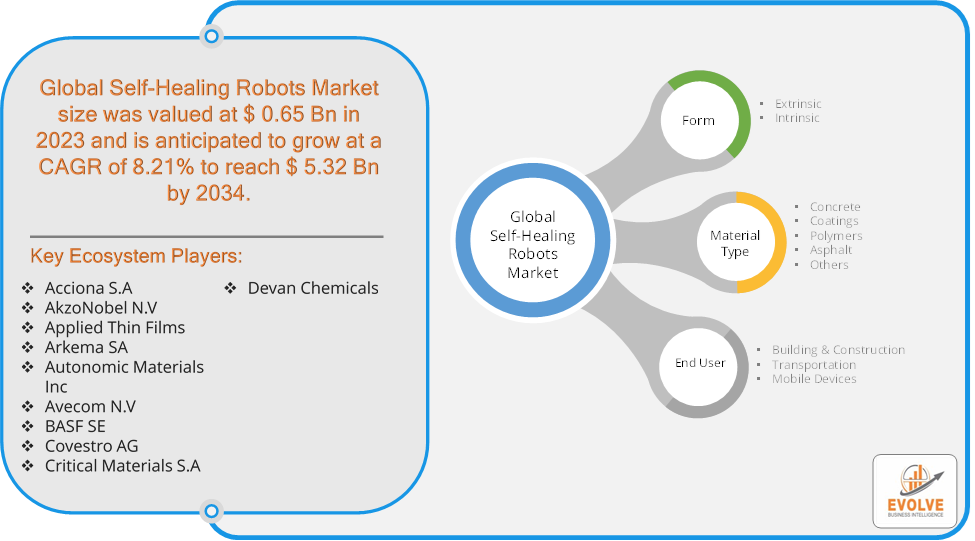Self-Healing Robots Market Grows: 8.21% CAGR

Evolve Business Intelligence has published a research report on the Global Self-Healing Robots Market, 2021–2034. The global Self-Healing Robots Market is projected to exhibit a CAGR of around 8.21% during the forecast period of 2021 to 2034.
Evolve Business Intelligence has recognized the following companies as the key players in the global Self-Healing Robots Market: Acciona S.A, AkzoNobel N.V, Applied Thin Films, Arkema SA, Autonomic Materials Inc, Avecom N.V, BASF SE, Covestro AG, Critical Materials S.A and Devan Chemicals.
 More Information: https://evolvebi.com/report/self-healing-robots-market-analysis/
More Information: https://evolvebi.com/report/self-healing-robots-market-analysis/
Market Highlights
The Global Self-Healing Robots Market is projected to be valued at USD 5.32 Billion by 2034, recording a CAGR of around 8.21% during the forecast period. The Self-Healing Robots Market involves the development and commercialization of robots equipped with the ability to autonomously repair or recover from damage. This capability is achieved through advanced materials and technologies that allow robots to detect damage and initiate repair processes without human intervention.
This market is evolving as researchers and companies work to address the challenges and unlock the full potential of self-healing technologies in robotics. As technology continues to advance, we can expect to see even more innovative and capable self-healing robots being developed to address a wide range of needs.
The COVID-19 pandemic had significant impacts on the Self-Healing Robots Market. The pandemic highlighted the need for automation and remote operations to minimize human contact. This led to a greater interest in advanced robotic technologies, including self-healing robots, which can operate more autonomously and reduce the need for human intervention. The urgency of dealing with health crises and disruptions in supply chains accelerated innovation in robotics, including self-healing technologies. Researchers and companies were motivated to develop more resilient and adaptable systems. There was an increased focus on healthcare robotics due to the pandemic, driving interest in robots that can handle hazardous environments and perform tasks autonomously. Self-healing robots, with their resilience and reliability, became more relevant in this context. The pandemic caused significant disruptions in global supply chains, affecting the availability of materials and components needed for the development and production of self-healing robots. This led to delays and increased costs.
Segmental Analysis
The global Self-Healing Robots Market has been segmented based on Form, Material Type and End User.
Based on Form, the Self-Healing Robots Market is segmented into Extrinsic and Intrinsic. The Intrinsic segment is anticipated to dominate the market.
Based on Material Type, the global Self-Healing Robots Market has been divided into Concrete, Coatings, Polymers, Asphalt and Others. The Concrete segment is anticipated to dominate the market.
Based on End User, the global Self-Healing Robots Market has been divided into Building & Construction, Transportation and Mobile Devices. The Building & Construction segment is anticipated to dominate the market.
More Information: https://evolvebi.com/report/self-healing-robots-market-analysis/
Regional Analysis
The Self-Healing Robots Market is divided into five regions: North America, Europe, Asia-Pacific, South America, and the Middle East, & Africa. In North America region, the United States and Canada are leading the market due to their strong emphasis on technological innovation, extensive research and development capabilities, and advanced industrial infrastructure. High investment in robotics and AI, robust presence of technology companies, and significant defense and healthcare sectors. In Europe region, Germany, the UK, France, and the Netherlands are significant contributors to the market in Europe. Advanced manufacturing sectors, focus on sustainability, and government initiatives to support robotics and AI research. In Asia-Pacific region, rapid industrialization, growing manufacturing sectors, and increasing investments in robotics and automation technologies. Expanding industrial automation, defense applications, and healthcare innovations. Growing demand for cost-effective solutions. In Latin America region, Brazil and Mexico are the leading countries in the Latin American market. Increasing interest in automation to improve manufacturing efficiency and address infrastructure challenges. In Middle East and Africa region, the market is developing with growing interest in automation and advanced technologies in countries such as the UAE and South Africa. Investments in infrastructure projects, defense, and efforts to diversify economies away from oil dependency.


